Sorry, this entry is only available in Brazilian Portuguese.
Tag: tecnologia de materiais
(Português) Oportunidade de bolsas de doutorado direto FAPESP em Eletroquímica Ambiental.
B-MRS Newsletter. Year 5, issue 10.
|
|||||||||||||||||||||||||
|
|||||||||||||||||||||||||
|
B-MRS announces new coordinator of the University Chapters (UCs)Program.
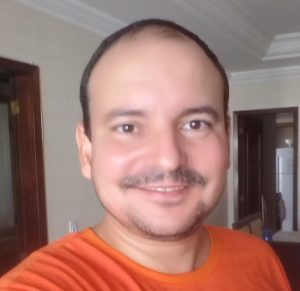
Professor Newton Martins Barbosa Neto of the Brazilian Federal University of Pará (UFPA) is the new coordinator of the University Chapters (UCs) Program of B-MRS. He follows in this role Professor Rodrigo F. Bianchi, who has coordinated the program since its foundation in 2014.
The objective of the UCs program is to bring together graduate and undergraduate students in Materials Science and Technology and related areas, and to encourage and support these teams to carry out activities that complement university education, such as the organization of events and interaction with similar groups from Brazil and abroad. Eight units of UCs have been created within B-MRS to date.
The board of B-MRS wishes Professor Barbosa Neto a good job and thanks Professor Bianchi for his work.
Words by the new coordinator (Newton Martins Barbosa Neto)
“I believe that assuming the coordination of B-MRS’s University Chapters program (UCs) is a major task. UCs are necessary and strategic bridges between today’s and tomorrow’s materials community as they provide students, in the spirit of learning by doing, the opportunity to evolve through the exchange of experience and discussion of problems related to materials research. Another important aspect of UCs is that they give students the opportunity to develop teamwork skills, which are more than necessary for the leaders of tomorrow, especially in a multidisciplinary area such as materials. It is in this spirit, and with the participation of our community, in Brazil and around the world, that I believe in the development of good work in the coming years that should continue to do what has already been done.
These are some of the main challenges we face: 1) Continue with the policy of creating new UCs, 2) Promote increasing interaction, and 3) Effectively organize the fields of action of UCs. The UCs have great action potential in activities such as: scientific dissemination, promotion of events, training of future researchers, among others. All of these things need to be done in an increasingly efficient and synergistic way, drawing the greatest number of results with the least amount of resources available. In other words, we need to do what we already do as materials scientists in our laboratories”.
Featured scientists: Interview with the winners of the Brazilian Award for best doctoral theses.
The list of the winners of the 2018 Capes Thesis Award was announced earlier this month. The award is given by Capes (the Brazilian federal government agency that is responsible for quality assurance in postgraduate courses in Brazil). It distinguishes the authors of the best doctoral theses defended in 2017 in postgraduate programs of Brazilian institutions. The awards ceremony will take place on December 13 in Brasilia.
The B-MRS Bulletin interviewed some of the winners, who were rewarded for their work on materials topics. Meet these young PhDs and their works.
Interview with Andrey Coatrini Soares, winner of the award for the best thesis in the area of Materials.
- Thesis: Nanostructured films applied in biosensors for the early detection of pancreatic cancer. Available at http://www.teses.usp.br/teses/disponiveis/18/18158/tde-30032017-080111/pt-br.php
- Author: Andrey Coatrini Soares.
- Advisor: Osvaldo Novais de Oliveira Junior (São Carlos Institute of Physics of USP – IFSC-USP).
- Institution: Postgraduate Program in Materials Science and Engineering of the University of São Paulo (USP).
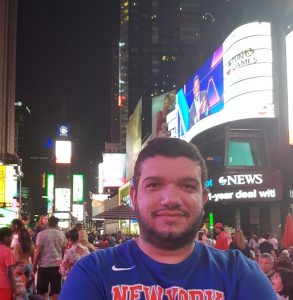
Andrey Coatrini Soares (born in Aguaí – SP, 33 years old) began increasing research experience in her first undergraduate year in Physics at USP, when he began his scientific initiation stage, which ended when he got his degree in 2010. He then decided to pursue a master’s degree and later a doctorate, both in the program in Materials Science and Engineering of USP. All along those years, he had the guidance of Professor Osvaldo Novais de Oliveira Junior, and worked with nanostructured films with applications in the health area. “Embracing a scientific initiation stage in the first undergraduate year and being able to work with researchers who are references in the field was crucial to accumulate experience in the area of the thesis subject,” says the Capes Award winner who continues to work with nanostructured films for health, now as a postdoctoral fellow at IFSC-USP.
In his doctoral research, Soares developed a low-cost sensor, made from renewable materials, which detects pancreatic cancer in 8 minutes. The research was carried out in the Prof. Bernhard Gross Polymer Group of IFSC-USP, in partnership with the Molecular Oncology Research Center of the Cancer Hospital of Barretos, and with the Microfabrication Laboratory of the National Center for Research in Energy and Materials (CNPEM). “The combination of experience in the clinical area of the Barretos team, experience in the area of photolithography/devices of the CNPEM team and the experience in biosensors and thin films of the São Carlos team allowed a rigid selection of what types of materials would be used , the types of devices to be tested and, mainly, which type of cancer would be detected,” says Soares.
B-MRS Newsletter: In your opinion, what is the most relevant contribution of the award-winning thesis?
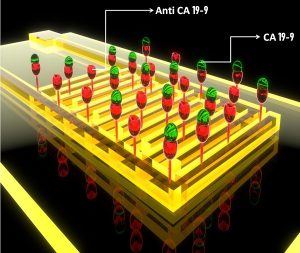
Andrey Coatrini Soares: The major problem for the diagnosis of pancreatic cancer is the silent characteristic of the disease; that is, the tumor is only detected at an advanced stage. Therefore, this type of cancer has the highest mortality rate among all cancers (99.3%, according to the International Agency for Research on Cancer, IARC). In addition, the current cost of the commercial diagnosis plus the detection time (approximately 40 minutes) are not allies of the patient. These were the key factors that led to our choice to develop a low-cost, low-speed miniaturized biosensor that could be implemented in clinics and hospitals, allowing clinicians, for example, to make decisions about patient care or analysis the efficiency of chemotherapy without the need to use invasive diagnoses.
B-MRS Newsletter: Cite the main results generated from the award-winning thesis.
Andrey Coatrini Soares: The work of the doctoral thesis developed a low cost diagnosis using biocompatible and biodegradable materials from renewable sources such as chitosan (found in shrimp exoskeleton) and concanavalin A (protein extracted from the seeds of Breadfruit). The versatility of these biosensors allows them to be implanted in patients for real-time screening of the biomarkers that are present in the blood. Each test costs R$ 5.00-6.00, which detects pancreatic cancer in just 8 minutes, using only 10μL of blood.
The thesis was also honored with the USP 2018 Thesis Highlight in the multidisciplinary area. It also has generated, to date, two papers published in the journals ACS Applied Materials and Interface and Analyst, an article in preparation, and 5 more works in collaboration with researchers who participated in the thesis, which report the development of other biosensors for the detection of breast cancer, head and neck cancer and HPV. These results have been widely disseminated in the media (Portal G1, FAPESP Research Magazine, FAPESP Agency, Portal Onconews,). In addition, a patent is under development and will be deposited in the future. The works are listed below:
- Soares, A. C.; Soares, J. C.; Shimizu, F. M.; Rodrigues, V.C.; Awan, I.T.; Melendez, M.E.; Piazzetta, M.H.O.; Gobbi, A.L.; Reis, R.M.; Fregnani, J.H.T.G.; Carvalho, A. L.; Oliveira Junior, O. N. A simple architecture with self-assembled monolayers to build immunosensors for detecting the pancreatic cancer biomarker CA19-9. Analyst 2018, 143, 3302-3308.
- Soares, A. C.; Soares, J. C.; Shimizu, F. M.; Melendez, M. E.; Carvalho, A. L.; Oliveira, O. N. Controlled Film Architectures to Detect a Biomarker for Pancreatic Cancer Using Impedance Spectroscopy. ACS Appl. Mater. Interfaces 2015, 7 (46), 25930–25937. DOI: 10.1021/acsami.5b08666
- Soares, A. C.; Soares, J. C.; Rodrigues, V.C.; Follmann, H. D. M.; Arantes, L.M.R.B.; Carvalho, A. C.; Melendez, M.E.; Reis, R.M.; Fregnani, J.H.T.G.; Carvalho, A. L.; Oliveira Junior, O. N. Microfluidic-Based Genosensors to Detect HPV16 in Head and Neck Cancer. ACS Applied Materials and Interfaces 2018.
- Thapa, A.; Soares, A. C.; Soares, J. C.; Awan, I. T.; Volpati, D.; Melendez, M. E.; Fregnani, J. H. T. G.; Carvalho, A. L.; Oliveira, O. N. Carbon Nanotube Matrix for Highly Sensitive Biosensors To Detect Pancreatic Cancer Biomarker CA19-9. ACS Appl. Mater. Interfaces 2017, 9 (31), 25878–25886
- Rodrigues, V.C; Comin, C. H.; Soares, J. C.; Soares, A. C. et al. Analysis of Scanning Electron Microscopy Images To Investigate Adsorption Processes Responsible for Detection of Cancer Biomarkers. ACS Appl. Mater. Interfaces 2017, 9 (7), 5885-5890.
- Soares, J. C.; Iwaki, L. E. O.; Soares, A. C. et al. Immunosensor for Pancreatic Cancer Based on Electrospun Nanofibers Coated with Carbon Nanotubes or Gold Nanoparticles. ACS Omega 2017, 2 (10) 6975-6983.
- Soares, J. C.; Soares, A. C.; Raymundo-Pereira, P. A. et al. Adsorption according to the Langmuir–Freundlich model is the detection mechanism of the antigen p53 for early diagnosis of cancer. RSC Phys. Chem. Chem. Phys. 2016, 18, 8412-8418.
- Soares, J. C.; Shimizu, F. M.; Soares, A. C.; Caseli, L.; Ferreira, J.; Oliveira, O. N. Supramolecular Control in Nanostructured Film Architectures for Detecting Breast Cancer. ACS Appl. Mater. Interfaces 2015, 7 (22), 11833–11841.
B-MRS Newsletter: From your point of view, what are the main factors that led to this outstanding research work at the national level (your thesis)?
Andrey Coatrini Soares: Teamwork, full dedication, in addition to funding from CAPES and FAPESP! In our work we had the participation of 12 researchers/collaborators in different areas of knowledge, from material engineers, chemists, physicists, physicians, geneticists and biologists. My sincere thanks to all of them: Prof. Osvaldo Novais de Oliveira Junior, my advisor and mentor, Dr. Juliana Coatrini Soares, Dr. Valquiria da Cruz Rodrigues, Dr. Flavio Makoto Shimizu, Dr. Maria Helena Piazzetta, Dr. Rui Murer, Dr. Angelo Luiz Gobbi, Dr. Matias Melendez, Dr. Lidia Rebolho Arantes, Dr. Rui Reis, Dr. José Humberto Fregnani and Dr. André Lopes Carvalho, as well as Dr. Rodrigo Marques de Oliveira and André Brisolari, responsible for guiding the first steps in science. The national emphasis achieved by the work is the result of the effort by the entire team, competent and cohesive, that to a certain degree strives to return to the population the investment made in our training, through a product that is accessible to all layers of society.
B-MRS Newsletter: Leave a message to our readers who are undergraduate or graduate students.
Andrey Coatrini Soares: Joining the academic arena means to be aware that virtually all learning will be built primarily by the questions you will ask, the mistakes you will make in trying to answer them, and how you will handle the challenges that the work will impose on you. It is within this growth that we learn to deal with the daily pressure for results and to face all the technical obstacles of the work. Undoubtedly, the satisfaction of overcoming each obstacle together with the satisfaction of contributing to science in a country that does not value researchers overcomes all the difficulties experienced during the doctoral period. Therefore, valuing each moment of individual or group work, every conversation with the advisor and, above all, valuing one’s achievements, even if they are minimal, is very important. And never leave behind the moments of leisure!
Interview with Bruno Ricardo de Carvalho, winner of the award for the best thesis in the area of Astronomy/Physics.
- Thesis: Raman Spectroscopy in MoS2-type Transition-Metal Dichalcogenides. Available at: http://lilith.fisica.ufmg.br/posgrad/Teses_Doutorado/decada2010/bruno-carvalho/
- Author: Bruno Ricardo de Carvalho.
- Advisor: Marcos Assunção Pimenta (Department of Physics, Federal University of Minas Gerais – UFMG): Available at: http://lilith.fisica.ufmg.br/posgrad/Teses_Doutorado/decada2010/bruno-carvalho/
- Co-advisors: Cristiano Fantini Leite (Department of Physics, Federal University of Minas Gerais – UFMG) and Mauricio Terrones (The Pennsylvania State University).
- Institution: Federal University of Minas Gerais (UFMG).
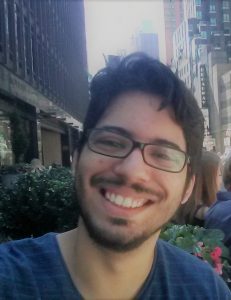
Bruno Ricardo de Carvalho (born in Cuiabá – MT, 29 years old) has always liked optics. When he was a child, he wanted to know why the sky is blue, how the rainbow is formed…. However, until a few years ago he had not imagined he would become a PhD in optical spectroscopy.
Carvalho holds a degree and a Master’s degree in Physics from the Federal University of Mato Grosso (UFMT). During the master’s degree, guided by professor Jorge Luiz Brito de Faria, he began to study two-dimensional nanomaterials through computational simulations. Influenced by the desire to analyze these materials experimentally, he decided to undergo a doctorate at the Federal University of Minas Gerais (UFMG) under the guidance of Professor Marcos A. Pimenta, who was the author of interesting articles Carvalho had read regarding nanomaterials analysis by the Resonant Raman Spectroscopy technique. Thus, working in the Raman Spectroscopy Laboratory of UFMG, Carvalho obtained the main results of the awarded thesis.
As soon as he started his doctorate, Carvalho showed interest in an internship abroad to learn about interaction with other research groups, and he expressed it to his advisor. Thus, upon completing two years of his doctorate, Carvalho moved to the city of State College in the United States, where he spent a year participating in several research projects on two-dimensional materials and their applications, at the State University of Pennsylvania under the guidance of professor Mauricio Terrones. “It was a very demanding year of total dedication and focus, but also very productive,” says Carvalho, recalling the articles generated during this period and published in high impact periodicals, the dissemination of results in international sites and the collaborations with theoretical and experimental research groups. Currently Bruno de Carvalho is an adjunct professor at the Department of Theoretical and Experimental Physics of the Federal University of Rio Grande do Norte (UFRN).
B-MRS Newsletter: In your opinion, what is the most relevant contribution of the awarded thesis?
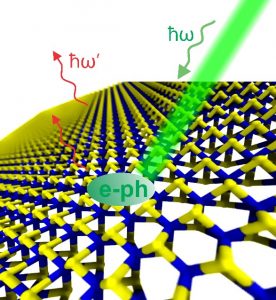
Bruno Ricardo de Carvalho: The main contribution is the double resonance model that we proposed to explain a Raman band, known as 2LA in MoS2, which is originated by a process of scattering between valleys. The new model presented to explain such a process can be extended to other two-dimensional systems. This was an open topic for more than 30 years in the scientific community, in the case of the material studied in the thesis, and we were able to propose an explanation.
B-MRS Newsletter: Cite the main results generated from the award-winning thesis.
Bruno Ricardo de Carvalho: In the thesis we wanted to demonstrate that we had a specific problem and that we solved. Thus, the study of resonant Raman spectroscopy in MoS2 was the focus of the doctoral thesis. This work generated the two main articles of the thesis.
- Carvalho, Bruno R.; Malard, Leandro M.; Alves, Juliana M.; Fantini, Cristiano; Pimenta, Marcos A.; Symmetry-Dependent Exciton-Phonon Coupling in 2D and Bulk MoS2 Observed by Resonance Raman Scattering. Physical Review Letters 114 (13), 136403 (2015).
- Carvalho, Bruno R.; Wang, Yuanxi; Mignuzzi, Sandro; Roy, Debdulal; Terrones, Mauricio; Fantini, Cristiano; Crespi, Vincent H.; Malard, Leandro M.; Pimenta, Marcos A.; Intervalley scattering by acoustic phonons in two-dimensional MoS2 revealed by double-resonance Raman spectroscopy. Nature Communications 8, 14670 (2017).
Other papers that were also mentioned in the thesis:
- Pimenta, Marcos A.; del Corro, Elena; Carvalho, Bruno R.; Fantini, Cristiano; Malard, Leandro M.; Comparative Study of Raman Spectroscopy in Graphene and MoS2-type Transition Metal Dichalcogenides. Accounts of Chemical Research 48 (1), 41-47 (2015).
- Feng, Simin; dos Santos, Maria C.; Carvalho, Bruno R.; Lv, Ruitao; Li, Qing; Fujisawa, Kazunori; Elías, Ana Laura; Perea-López, Nestor; Endo, Morinobu; Pan, Minghu; Pimenta, Marcos A.; Terrones, Mauricio; Ultrasensitive molecular sensor using N-doped graphene through enhanced Raman scattering. Science Advances 2 (7), e1600322 (2016).
- Carozo, Victor; Wang, Yuanxi; Fujisawa, Kazunori; Carvalho, Bruno R.; McCreary, Amber; Feng, Simin; Lin, Zhong; Zhou, Chanjing; Perea-Lopez, Nestor; Elias, Ana Laura; Kabius, Bernd; Crespi, Vincent H.; Terrones, Mauricio; Optical identification of sulfur vacancies: Bound excitons at the edges of monolayer tungsten disulfide. Science Advances 3 (4), e1602813 (2017).
B-MRS Newsletter: From your point of view, what are the main factors that led to this outstanding research work at the national level (your thesis)?
Bruno Ricardo de Carvalho: The infrastructure of the laboratory and of the institution where I conducted the research was fundamental to develop the work. The discussion with my mentors and the collaboration regime, made the work more robust and elegant, that is, when people from different points of view work together.
B-MRS Newsletter: Leave a message to our readers who are undergraduate or graduate students.
Bruno Ricardo de Carvalho: My message is that they dedicate themselves to what they do. The doctorate is a phase of intense learning and dedication. To do science is to have a systematic posture, an open mind, a critical posture and spend many hours in the laboratory. All of this, with effort and dedication, generates work that will be recognized. And, much more than that, it will be work that you did and in my opinion this is the greatest satisfaction.
Interview with Henrique Bücker Ribeiro, winner of the award for the best thesis in the area of Engineering IV.
- Thesis: Raman spectroscopy in two-dimensional materials. Available at: http://tede.mackenzie.br/jspui/handle/tede/3485
- Author: Henrique Bücker Ribeiro.
- Advisor: Eunézio Antonio de Souza (Mackenzie Presbyterian University).
- Coordinator: Marcos Assunção Pimenta (Department of Physics, Federal University of Minas Gerais – UFMG).
- Institution: Graduate Program in Electrical and Computer Engineering, Mackenzie Presbyterian University.
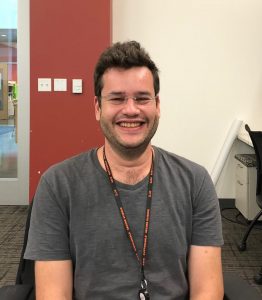
Henrique Bücker Ribeiro (born in Belo Horizonte, MG, 36 years old) was a student of the Physics bachelor’s degree at the Federal University of Minas Gerais (UFMG), when, in 2004, he started to analyze low-dimensional materials (those ranging from 1 atom to a few nanometers of thickness) using the Raman spectroscopy technique. Within a scientific initiation stage, guided by Professor Marcos Pimenta, he studied carbon nanotubes. In addition to guiding Ribeiro early in his career, Professor Pimenta introduced two professors from the Mackenzie Presbyterian University, Eunézio Antonio de Souza and Christiano José Santiago de Matos. “They played and play until now, alongside Marcos, irreplaceable roles as mentors and friends,” says Ribeiro.
From that contact, in 2014, Ribeiro began his doctorate at Mackenzie. There, he continued to study low-dimensional materials using Raman spectroscopy. Ribeiro started with bi-layered graphene and then continued with black phosphorus and monochalcogenides. In addition to the infrastructure at Mackenzie, Ribeiro used equipment from UFMG, CTNnano (Belo Horizonte), LNNano (Campinas), as well as computing centers from Unesp and Unicamp. Ribeiro’s thesis did not only generate knowledge about the studied materials, but also helped to improve the use of the Raman technique to probe this type of materials. Today, Ribeiro is in a postdoctoral program at Stanford University with the help of a FAPESP grant, where he continues to study low-dimensional materials, more precisely, optoelectronic processes of two-dimensional semiconductors.
B-MRS Newsletter: In your opinion, what is the most relevant contribution of the awarded thesis?
Henrique Bücker Ribeiro: I believe that the most important contribution of the thesis was to explain an unexpected effect observed when measuring the angular dependence of Raman spectra on black phosphorus. We were able to explain with this study that when analyzing the angular dependence of the Raman spectra for certain crystals, it is necessary to consider an unusual mathematical treatment. This work has become an important reference for researchers working with low dimensional materials similar to black phosphorus.
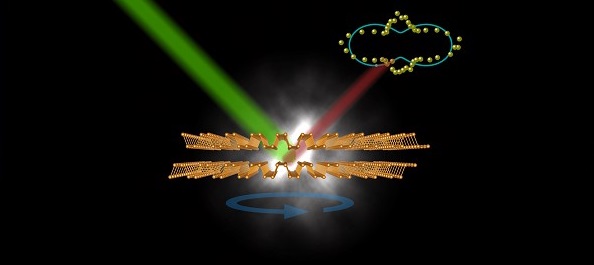
B-MRS Newsletter: Cite the main results generated from the award-winning thesis.
Henrique Bücker Ribeiro: The work mentioned above generated an article (https://pubs.acs.org/doi/full/10.1021/acsnano.5b00698) that currently has more than 130 citations and is in the 1% of most cited articles in the area according to Essential Science Indicators, produced by Clarivate Analytics of the Thomson Reuters group.
The thesis is related to the following articles:
- RIBEIRO, HENRIQUE B.; PIMENTA, MARCOS A. ; DE MATOS, CHRISTIANO J. S. ; MOREIRA, ROBERTO LUIZ ; RODIN, ALEKSANDR S ; ZAPATA, JUAN D. ; DE SOUZA, EUNEZIO A. T. ; CASTRO NETO, ANTONIO H. . Unusual Angular Dependence of the Raman Response in Black Phosphorus. ACS Nano, v. 9, p. 4270–4276, 2015.
- RIBEIRO, H. B.; VILLEGAS, C. E. P. ; BAHAMON, D. A. ; MURACA, D. ; CASTRO NETO, A. H. ; de SOUZA, E. A. T. ; ROCHA, A. R. ; PIMENTA, M. A. ; de MATOS, C. J. S. . Edge phonons in black phosphorus. Nature Communications, v. 7, p. 12191, 2016.
- RIBEIRO, HENRIQUE B.; PIMENTA, MARCOS A. ; DE MATOS, CHRISTIANO J.S. . Raman spectroscopy in black phosphorus. JOURNAL OF RAMAN SPECTROSCOPY, v. 49, p. 76-90, 2018.
- RIBEIRO, H.B.; SATO, K. ; ELIEL, G.S.N. ; DE SOUZA, E.A.T. ; LU, CHUN-CHIEH ; CHIU, PO-WEN ; SAITO, R. ; PIMENTA, M.A. . Origin of van Hove singularities in twisted bilayer graphene. Carbon (New York), v. 90, p. 138-145, 2015.
In addition to articles from collaborations:
- ELIEL, G. S. N. ; MOUTINHO, M. V. O. ; GADELHA, A. C. ; RIGHI, A. ; CAMPOS, L. C. ; RIBEIRO, H. B. ; CHIU, PO-WEN ; WATANABE, K. ; TANIGUCHI, T. ; PUECH, P. ; PAILLET, M. ; MICHEL, T. ; VENEZUELA, P. ; PIMENTA, M. A. . Intralayer and interlayer electron-phonon interactions in twisted graphene heterostructures. Nature Communications, v. 9, p. 1221, 2018.
- ELIEL, G. S. N. ; RIBEIRO, H. B. ; SATO, K. ; SAITO, R. ; LU, CHUN-CHIEH ; CHIU, PO-WEN ; Fantini, C. ; RIGHI, A. ; PIMENTA, M. A. . Raman Excitation Profile of the G-band Enhancement in Twisted Bilayer Graphene. BRAZILIAN JOURNAL OF PHYSICS, v. 47, p. 589-593, 2017.
- COSTA, M C FERRAZ DA ; RIBEIRO, H B ; KESSLER, F ; SOUZA, E A T DE ; FECHINE, G J M . Micromechanical exfoliation of two-dimensional materials by a polymeric stamp. Materials Research Express, v. 3, p. 025303, 2016.
- FARIA, PAULA C. ; SANTOS, LUARA I. ; COELHO, JOAO PAULO ; RIBEIRO, HENRIQUE BUCKER ; PIMENTA, MARCOS A. ; LADEIRA, LUIZ O. ; GOMES, DAWIDSON A. ; FURTADO, CLASCIDIA A ; GAZZINELLI, RICARDO . Oxidized multiwalled carbon nanotubes as antigen delivery system to promote superior CD8+ T cell response and protection against cancer. Nano Letters (Print), v. 14, p. 5458-70, 2014.
During my PhD I was awarded the Nanocell Institute of Scientists of the Year Award in the category ‘Nanotechnology: from production to application’.
B-MRS Newsletter: From your point of view, what are the main factors that led to an outstanding research work at the national level (your thesis)?
Henrique Bücker Ribeiro: Open dialogue with my mentors, collaborations, development agencies, the post-graduation program and the university, discussions with colleagues, support from my parents, support from technicians, a good work environment, dedication and effort and many other factors. Good work can be achieved when all these elements are in place. The absence of just one is enough to jeopardize the work.
B-MRS Newsletter: Leave a message to our readers who are undergraduate or graduate students.
Henrique Bücker Ribeiro: Do not expect good results to materialize immediately and do not be discouraged when this is the case. Most of the time things will go wrong and even then, nothing will be wasted. A good result can be achieved by overcoming these difficulties and thinking about the problem.
Interview with Adriano dos Santos, winner of the award for the best thesis in the area of Chemistry.
- Thesis: Development of an impedimetric/capacitive biosensor for the detection of biomarkers of clinical importance. Available at: https://repositorio.unesp.br/handle/11449/150274
- Author: Adriano dos Santos.
- Advisor: Paulo Roberto Bueno (Institute of Chemistry of Araraquara – UNESP).
- Co-advisor: Maria del Pilar Taboada Sotomayor (Institute of Chemistry of Araraquara – UNESP).
- Institution: Institute of Chemistry of Araraquara, State University of São Paulo (UNESP).
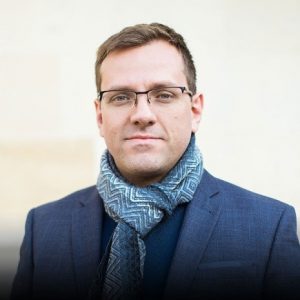
For Adriano dos Santos (35, a native of Araraquara, São Paulo), the laboratory classes he had in the Chemistry undergraduate course at UNESP, in the Araraquara campus, were genuine foundations of his education. The tools and competences developed in these practical classes were very useful for Santos, both in the stages he performed in a company that produces paints and coatings, and in the stages of scientific initiation at UNESP, under the guidance of professors Antonio Eduardo Mauro and Paulo Roberto Bueno.
In 2010, Santos began his Master’s in Chemistry, also at UNESP under the guidance of Professor Bueno. During the master’s research, in which he developed a piezoelectric device to understand a biological process, Santos began to learn about biosensors-related topics and to develop a special interest in this research area. After defending the dissertation, and while working in a chemical company, Santos decided to do a doctorate in a subject related to biosensors. In 2013, he began the doctorate activities. Again under the guidance of Professor Bueno and co-advised by Professor Maria del Pilar Taboada Sotomayor, he developed his research project at the Institute of Chemistry of Araraquara, UNESP. From September 2016 to February 2017, Santos was at the University of Oxford (England) performing part of the research under the guidance of Professor Jason Davis. “This enabled me to expand my knowledge and critical analysis with invaluable gains in professional experience and qualification,” says Santos.
In his thesis, Santos presented a new application of existing techniques that generated biosensors with possible applications in the detection of thrombosis and cancer and in the study of biological phenomena. Currently, the prize winner continues working in this area with Professor Bueno, as a postdoctoral fellow.
B-MRS Newsletter: In your opinion, what is the most relevant contribution of the awarded thesis?
Adriano dos Santos: Biosensors are currently receiving considerable attention due to their economic (investment and market) and social (health impact and population quality of life) potential. These devices, in which the glucometer (device that measures the glucose content directly from the blood) is its greatest example, have the capacity to perform clinical diagnosis faster than the current methods, as well as limits of detection (smaller amount that can be detected in a sample) that is suitable for early diagnosis. Early detection is highly relevant when, for example, performing cancer diagnosis is desired. This is because the chances of cure and the survival time of patients with this disease are greatest when detected in the early stages.
In my thesis it was demonstrated that by means of an electrochemical transduction of a biological recognition signal, called electrochemical capacitance, and also through new data analysis known as immitance functions, there is the potential to diagnose certain diseases in a sensitive and early manner, including cancer and thrombosis, without the need to use enzymatic or fluorescent labels used in the current clinical analysis. In addition, the use of this innovative electrochemical approach in the development of interfaces with potential applications in glycobiology is also unprecedented. The importance of this approach is to provide a new tool that will help researchers understand processes that are related to the interaction of proteins and carbohydrates. In this context, it is possible to encompass cellular invasion processes (whose knowledge may assist in the development of vaccines), and the understanding of the mechanism of tumor formation and proliferation. It is possible that this new approach may one day be employed in developing a technological platform for the development of glycoarrays (that is, techniques that allow the study of interactions between proteins and carbohydrates).
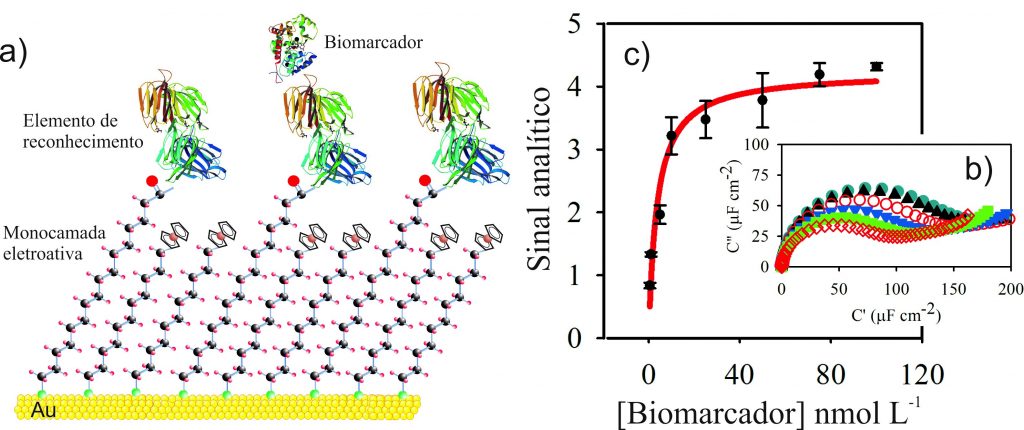
B-MRS Newsletter: Cite the main results generated from the award-winning thesis.
Adriano dos Santos: Specifically from the thesis, there were five published works:
In addition, during the period of my PhD research, there were six more articles published, in partnership, on topics related to the thesis.
It is also important to emphasize that during this period, a clinical diagnosis company was created, with my thesis supervisor, Prof. Dr. Paulo Roberto Bueno, and Prof. Dr. Jason Davis of the University of Oxford, as the founders. This company, Osler Diagnostics, is a spinout located in the city of Oxford, England, which is using part of the research generated in this thesis for its technological development.
B-MRS Newsletter: From your point of view, what are the main factors that led to this outstanding research work at the national level (your thesis)?
Adriano dos Santos: There are many factors, such as the infrastructure of the institution that contains equipment and professionals capable of performing tests and measurements that underlie the theory, as well as research support from the library to the post-graduate technical section, including the entire staff; the excellence of the group of researchers from UNESP – Institute of Chemistry, which includes my advisor (Prof. Dr. Paulo Roberto Bueno) and co-adviser (Prof. Maria Del Pilar Taboada Sotomayor) of the thesis, who assisted me with much advice and learning; the possibility of attending international scientific events, in which the importance of mastering English as a second language was crucial to promote the exchange of knowledge with the researchers in the events; the partnership between UNESP and Oxford University through a MoU (Memorandum of Understanding), which encourages researchers to carry out academic cooperation, raising the level of scientific discussion, and from which favored my internship abroad at this university, under the guidance of Prof. Dr. Jason Davis; and the funding of federal (CAPES and CNPq) and state (FAPESP) agencies through thematic projects and a doctoral grant.
I would like to take this opportunity to thank the Institute of Chemistry-Campus of Araraquara (technicians, professors and researchers) involved in my thesis, to the University of Oxford, especially to Prof. Dr. Jason Davis, for having welcomed me to his laboratory, family and friends, as well as CAPES, CNPq and FAPESP for the financial support.
B-MRS Newsletter: Leave a message to our readers who are undergraduate or graduate students.
Adriano dos Santos: Science is beautiful, and like a sculpture it requires the effort to polish the stone so the art is revealed. The journey to the goal is like a course, often tortuous, that deceives us and forces us to redirect our trajectories. Science is not linear, in that knowledge is ready and finished, but rather a constant review and advance of what is being done, especially for applications in new technologies, which require “returns” and new interpretations of knowledge previously seen as untouchable. Thus, it can be characteristic for the undergraduate student (when in a scientific initiation), and especially for the postgraduate, to encounter unexpected or difficult to interpret results, which may often be grounds for discouragement and abandonment of his/her research project. The only way to overcome these problems is through ethical conduct and professionalism, knowing how to recognize one’s limitations and seek continuous help from his or her supervisor or other researchers in the area. And also always be open-minded and question oneself, not with skepticism, but with consideration to understand the system that is the study object.
Not less important is to remember that it is necessary for family to be close and for friendships to be cultivated. Setting aside leisure time such as hobbies and reading, different from those we are usually accustomed to in academia, are crucial. Consider practicing a physical activity and studying a second language, especially English, as there will certainly be opportunities in which that language will be crucial for career advancement, whether as a university professor or as a professional in a company.
(Português) Seleção para mestrado e doutorado no POSMAT – UNESP.
(Português) Seleção para mestrado e doutorado em Ciência dos Materiais na Unesp de Ilha Solteira.
B-MRS Newsletter. Coverage of the XVII B-MRS Meeting.
|
|||||||||||||||||||||||||||||||||||
|
|
XVII B-MRS Meeting: Report on the technical sessions.
For a high-impact, diverse and inclusive science (Workshop Young Researchers’ School)
Sunday, September 16, around 1:00 p.m. City of Natal, State of Rio Grande do Norte, Brazil. The sky was blue and the sea was green. Possibly resisting the temptation of a Sunday afternoon at the beach, about 150 people decided to go to the Convention Center of the traditional Hotel Praiamar, located a few meters from the Ponta Negra Beach – the most famous in the touristic Natal. The reason for this strange decision? To participate in the Young Researchers’ School workshop, a four-hour activity offered at no additional cost to those enrolled in the XVII B-MRS Meeting.
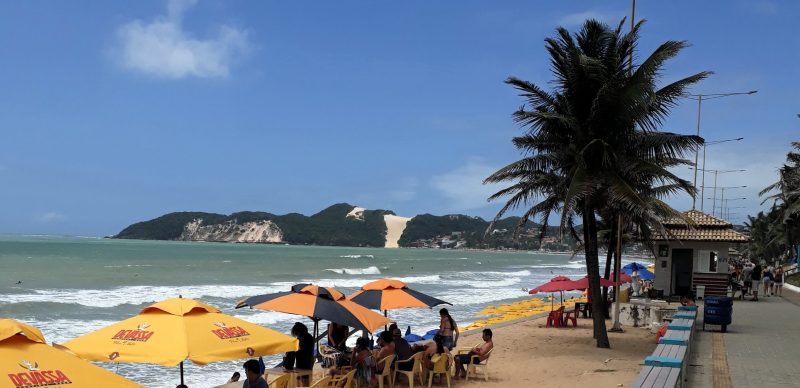
The workshop started with a tutorial by Professor Valtencir Zucolotto (University of São Paulo, USP, Brazil), a member of the Brazilian Materials research community known not only for the research of Nanomedicine and Nanotoxicology Group, but also for the lectures, online courses and workshops on scientific writing and publishing that he creates and presents in Brazil and abroad. Good humored and interacting with the audience, Zucolotto talked about how to do high impact research, from the initial idea to the publication of the paper, covering the research methodology and the writing of the paper. In addition to showing data, Professor Zucolotto shared his experiences “on the two sides of the aisle” (Zucolotto is a productive and cited researcher, as his 42 H index shows, and also edits journals and books). The speaker also gave advice from someone who has gone through this to the younger members of the audience “One must learn to live with rejection, which is part of the work of a scientist,” said Zucolotto, referring to the rejection of papers during the publication process. “Don’t worry, your paper will be rejected… and will be finally accepted in a high-impact journal,” he joked.
[See Professor Zucolotto’s course material at the site http://zucoescrita.com ]
After a generous coffee break sponsored by Elsevier, the workshop continued with the presentation of Elsevier’s Director of Publication of the Materials Science area, Christiane Barranguet, on the diversity and inclusion in the environment of journals and scientific events. In addition to showing data on female participation in science, the director recounted the company’s efforts to achieve gender and geographical diversity and representativeness in the editorial bodies of the journals and in the group of panelists of the conferences. Good results have appeared shyly, she pointed out. However, women and Latin Americans are still underrepresented in these groups. At the end of the lecture, Barranguet invited the Materials community to indicate names of scientists, mainly from underrepresented groups, who could work in the editorial bodies of Elsevier journals.
[See Christiane Barranguet’s presentation file in our Slideshare https://www.slideshare.net/SBPMat/how-can-academic-publishing-increase-diversity-and-inclusion ]
The last part of the workshop returned to the question of the impact of publications, precisely where Professor Zucolotto had stopped. Marlene Silva, also from Elsevier’s Materials team, talked about ways to disseminate a published paper to increase its visibility, citation potential, and academic and social impact. According to the speaker, the dissemination work should be carried out without wasting time, in the pleasure derived from the news of having the paper accepted. One of the most useful tools for this dissemination is, according to Silva, the URL sharing link – made available to the authors of the papers by most of Elsevier’s journals, which grants direct and free access to the paper for 50 days to anyone who receives the link. Silva recommended sharing this link by all possible means, from all social media, accompanied by texts and attractive images, to the author’s e-mail signature. The speaker also talked about strategies to make the article more relevant in search engines, known as SEO, such as repeating the most relevant keywords all along the paper.
[See the presentation file of Marlene Silva in our Slideshare https://www.slideshare.net/SBPMat/how-to-promote-your-article-116520984 ]

Tough, stiff and resilient: the Brazilian materials research community (Opening Ceremony)
A pleasant surprise awaited the approximately 800 participants who settled in the main hall of the Convention Center around 7:30 p.m. to attend the Opening Ceremony. Shortly after the opening words by the master of ceremonies, twelve musicians from the “Orquestra Potiguar de Clarinetas“, from the School of Music of the Federal University of Rio Grande do Norte (UFRN), left their hiding places with their instruments, stood near the stage and filled the room with Brazilian music – mainly compositions from the Northeast region. The musicians showed a sample of the richness and cultural diversity of this country, playing the rhythms of choro, baião, frevo and carimbó.
After the musical presentation, the Opening Table was set up, composed of Professor Antonio Eduardo Martinelli (Chairman of the XVII B-MRS Meeting), Professor Osvaldo Novais de Oliveira Jr (President of B-MRS), Professor Rodrigo Ferrão de Paiva Martins (Second Vice President of the International Union of Materials Research Societies, IUMRS) and Professor José Daniel Diniz Melo (Vice-Rector of UFRN).
Then, those standing on the stage and in the audience, sang the Brazilian National Anthem, accompanied by the Symphony Orchestra and Madrigal Chorus of UFRN projected on the screens scattered throughout the room.
In addition to welcoming and thanking everyone, in the words of the members of the table, there were several references to the social and economic importance of research in Materials. “Knowledge of this area is crucial to solve most of the problems of society,” said Diniz Melo, who is also a professor of undergraduate and postgraduate studies in Materials at UFRN. The Portuguese Rodrigo Martins, who besides being an internationally prominent Materials scientist, is a frequent participant in the B-MRS Meetings, highlighted the role of materials in the development of a country. “From life sciences to aerospace industry, materials are central to all developments and bring a better quality of life to the population,” said Martins. “This event is a celebration of what Materials Science has done for the society,” said Professor Oliveira Junior.
In an inspiring opening speech, Professor Martinelli addressed a subject that has troubled the Brazilian scientific community. “Not only economic difficulties but mainly the sense of what are and what are note priorities for our country have burned part of our past and challenged the best chances to improve Science and Technology in Brazil, putting at risk a better future for current and future generations,” said the chair of the event, who is a professor of undergraduate and post-graduate studies in Materials at UFRN and coordinator of the Materials Area at the federal agency CAPES. The chair highlighted the strength of the Materials community that, even within this context, has remained active and allowed the event to take place, with a large number of participants. “We are materials people: tough, stiff and resilient,” Martinelli said. “No one has given up, and no one will”.

Tributes to prominent members of the community (Memorial Lecture “Joaquim da Costa Ribeiro”)
After the words by the members of the table, the moment came for B-MRS to pay tribute to the long and distinguished trajectory of Brazilian scientists. The first tribute, which was not announced in the program, was for Professor Aloísio Nelmo Klein (Federal University of Santa Catarina, Brazil), who received a commemorative plaque and a gift for his “35 years dedicated to Applied Science.” In fact, Klein’s scientific career stands out mainly by the number of patents (more than 60 applications filed in offices in Brazil, Europe, the United States, China, South Korea, Japan, Taiwan, Singapore and Australia) and numerous projects in partnership with companies. Professor Klein, who is a founding member of B-MRS and has previously served as scientific director, adviser and chairman of two annual meetings of the society, received gratitude and recognition from the president of B-MRS for his long-term dedication to this society.
[See the February 2017 interview with Professor Aloísio Nelmo Klein https://www.sbpmat.org.br/en/gente-da-comunidade-entrevista-com-o-pesquisador-aloisio-nelmo-klein/ ]
The second person to be honored that night was Professor Fernando Galembeck, retired from UNICAMP since 2011, but still active, who is also Collaborating Professor of that university. Throughout the four decades of his scientific career, Galembeck made important contributions to applied and basic research in diverse subjects such as surface modification, nanoparticles, nanocomposites, electrostatics, materials derived from biomass, among other subjects. He is the author of more than 250 papers, 35 patents and 20 books or book chapters, and has more than 3,700 citations. He was a founding member of B-MRS.
[See interview of Fernando Galembeck, updated and reissued in August 2018 https://www.sbpmat.org.br/en/cientista-em-destaque-entrevista-com-fernando-galembeck-que-proferira-a-palestra-memorial-no-xvii-encontro-da-sbpmat-reedicao-atualizada-de-entrevista-de-maio-de-2015/ ].
Galembeck was chosen this year to receive the main B-MRS honor for researchers with an outstanding trajectory in the area of Materials, the Memorial Lecture “Joaquim da Costa Ribeiro”. This distinction also honors, through its name, a pioneer of experimental Materials research in Brazil.
[See article on Joaquim da Costa Ribeiro https://www.sbpmat.org.br/en/historia-da-pesquisa-em-materiais-joaquim-da-costa-ribeiro-e-o-efeito-termodieletrico/ ]
In the first part of his talk, Galembeck addressed the relationship between raw materials, energy and food, given that hunger is still a problem for humanity, and that energy generation can compete with food production by using the same raw materials. This situation worsens, said Galembeck, when financial speculation comes into play. However, he urged, thanks to technological advances, it is possible to produce goods by combining cheap energy from inexhaustible sources like the sun and wind, with abundant raw materials such as lithium, magnesium and carbon dioxide, or even waste. “Waste is untapped opportunity,” highlighted the speaker. With respect to the use of biomass in developing countries, he stated that, in addition to generating energy by reducing the country’s dependence on fossil fuels, it can be used as raw material for high added value products, generating better income for the population. In the second part of the lecture, Galembeck presented an overview of some of his scientific contributions. The scientist also expressed his optimism about the crisis that Brazil is going through, which was addressed earlier by Professor Martinelli. “I’m experienced enough to know that in the end everything will be better than expected,” he stated.
[See Fernando Galembeck’s presentation file in our Slideshare https://www.slideshare.net/SBPMat/materials-for-a-better-future ]
After the lecture, the participants left the Convention Center and, a few meters away, were able to enjoy the welcome cocktail of the event, held in an outside lounge of Hotel Praiamar, enjoying the sea breeze under a starry sky with a crescent moon.

Theory and experiments, industry and academia and multidisciplinarity (Oral and Poster Sessions of the symposia)
The Brazilian members of the materials research community, who were majority in the event, has remained active throughout this difficult year, said the chair at the opening of the meeting. This could be confirmed by simply sitting down in the oral presentation rooms or walking by the poster’s white tent (preferably with a smartphone in hand, to access and save the abstract and data of the posters of interest).
More than a thousand Materials research professionals and students presented their works and discussed them with their peers at the XVII B-MRS Meeting. Despite the high percentage of those enrolled with approved papers who did not attend the event (about 30%), most likely due to of the lack of funding, the symposia held significant participation in the oral and poster sessions. Some symposium organizers went beyond these traditional presentation formats and included discussion forums in their programs. They broke with the linear sitting arrangements and encouraged collective discussions in semicircles, regarding topics they considered as particularly important. Another highlight of the symposia this year, according to the organizers, was the quality of the invited lectures (30-minute presentations given by experts on topics within the scope of the symposium, which are invited by the organizers).
The thematic range covered by the symposia was once again broad and comprehensive. Many materials were covered (nanomaterials, conductive polymers, advanced metals, composites, metal oxides, electroceramics, biomaterials, surfaces, coatings). Many applications were presented (for the segments of energy, aerospace, health, electronics, bioelectronics, photonics, automotive, decorative). Several interactions took place: between different people, between the theoretical and the experimental, between industry and academia, between science and technology, between areas of knowledge (Chemistry, Physics, Biology, Engineering, Medicine).
Among the symposia of this edition of the event, there were old acquaintances (such as the Brazilian Eletroceramics Symposium, in its eleventh edition), newer symposia (such as the one about Surface Engineering) and totally new symposiums, such as the symposium on nanofibers and applications.
The symposia of the XVII B-MRS Meeting were organized by 76 researchers linked to education and research institutions or companies from Brazil, Argentina, Canada, Chile, Germany, Portugal, Spain, and USA.
[See the highlights of the symposiums, sent by some of the organizers https://www.sbpmat.org.br/en/xvii-b-mrs-meeting-highlights-of-the-symposia/]

Lectures on scientific instrumentation
Located between the entrance to the Convention Center and the Secretariat of the event, on the way to the plenary lecture room, the exhibitors’ area was full of activity, and not just during the coffee break, which was served at the event. Twenty companies and UFRN were there with their booths staffed by specialists, their publicity materials, gifts and, in some cases, equipment for demonstrations. In addition, on Wednesday, some of the scientific instrumentation companies offered ten technical lectures showing the advances and the new applications of various characterization techniques, as well as innovations in laboratory equipment.
And the participation of the exhibitors went beyond the technical specifics. Solidus, a junior company of Materials and Mechanical Engineering that participated in the event at the UFRN booth provided a photo frame for visitors who wanted to take a souvenir photo of the XVII B-MRS Meeting and share it in social networks.

Student proposals for the future Aerospace Industry (The “Aerospace Materials and Manufacturing for the Next Century” challenge)
One of the highlights of the event was the technological challenge of the aerospace industry for undergraduate and graduate students attending the meeting. In order to motivate students to carry out multidisciplinary research with aerospace applications, and to bring the academic environment and industry closer together, the activity was conceived and organized by a group of researchers from Brazilian universities and two leading companies in the aerospace segment, the US Boeing and the Brazilian Embraer.
The activity began on Monday, September 17, when 55 students, interested in participating in the challenge previously announced by the B-MRS channels, registered at the Boeing booth (Diamond Sponsor of the event), located in the exhibitors’ area of the convention center. At the end of the day, a lottery defined who would be the participants in this challenge.
The following day, at lunchtime, experts presented six technical challenges related to problems or opportunities in the aerospace industry for 36 students who were having lunch in the audience – the lunch boxes were sponsored by Boeing. After the presentations, the students formed the respective work teams.
24 hours later, the six groups had to present their solutions in English, while they were evaluated in terms of originality, technical content, alignment with the proposed challenge, solution implementation potential and presentation quality. The jury consisted of nine researchers from the Materials area of Brazil and abroad, linked to Boeing, Embraer, as well as education and research institutions.
The following day, during the Awards Ceremony of the event, Catherine Parrish, Senior Coordinator of Materials and Process Engineering Research at Boeing, and Fabio Santos da Silva, Senior Technology Development Engineer at Embraer, announced the winning work and delivered diplomas and gifts to the members of the winning team, composed of five masters and PhD students in Materials, Chemistry and Physics from institutions in the South, Northeast and Midwest regions of Brazil. “We are very happy with the results of the challenge. The participants presented really innovative ideas; it was fantastic,” Parrish said.
Responding to the challenge “Aerospace Structures and Systems Inspired by Nature – Lotus Leaf,” the winning team presented the properties of the lotus leaf, especially its super-hydrophobia and its consequent self-cleaning ability. The students suggested applications in the aerospace segment (mainly in the aircraft fuselage) of materials with lotus leaf-inspired surfaces, and proposed ways to obtain these surfaces. “What I learned from this challenge was that staying calm is very important for developing a project, and helping others wherever possible. Each one gives their contribution and together we add individual skills,” states Angelica Belchior Vital, Ph.D. student in Chemical Engineering at UFRN and a member of the award-winning team. “We had a great time and we were really excited with the ideas and discussions the work generated,” she adds.

Sustainability and academic and social impact in the views of world-renowned scientists (Plenary lectures)
Two plenary lectures per day. Eight scientists with outstanding trajectory shared with the participants throughout their expertise in subjects of great academic, social and economic impact. Pillars of the B-MRS meetings, the plenary lectures of this edition of the event gathered a few hundred participants and showed the crucial role of Materials research in subjects such as sustainability and health.
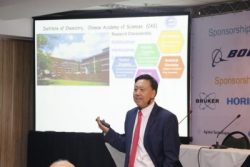
At the first plenary session of the event, Professor Junbai Li, from the Institute of Chemistry of the Chinese Academy of Sciences, revealed how he helps nature to assemble nano and micro structures from biological molecules. More precisely, Li, who is the editor-in-chief of Colloids & Surfaces A (Elsevier) and editor of the self-assembly section at Current Opinion in Colloid & Interface Science (Elsevier), uses a type of amino acid (peptides) as basic block to form structures by means of self-assembly processes. The prominent Chinese scientist is able to control the architecture of structures, generating shapes similar to tubes, platelets, vesicles or flowers. The lecturer showed that these biocompatible structures can be used to staunch bleeding, cure skin diseases and carry drugs. At the end of the lecture, he ensured that peptide-based materials will be part of everyday life in a few years.
[See the plenary file of Junbai Li in our Slideshare https://www.slideshare.net/SBPMat/molecular-assembly-of-peptide-based-materials-towards-biomedical-application ]
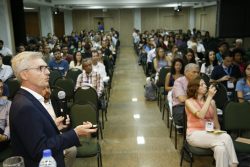
The afternoon plenary was delivered by a scientist who has been working for 25 years at the R&D of Vacuumschmelze, a manufacturer of advanced magnetic materials and related products, born in Germany and present in dozens of countries. Christian Polak spoke about some of the materials developed in the company (amorphous and nanocrystalline magnetic alloys), their manufacturing processes and their applications in products that are part of the company’s portfolio; for example, transformers, converters and electric current sensors. In the lecture, it was possible to verify that the application of highly specialized scientific knowledge results in widely marketed products and innovations that accompany the demands of the consumer market, such as components to improve the performance of smartphones.
[See the plenary file of Christian Polak in our Slideshare https://www.slideshare.net/SBPMat/soft-magnetic-nanocrystalline-materials-for-inductors-and-shielding-applications-optimized-for-higher-frequencies]
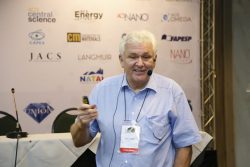
On Tuesday morning, the plenary lecture was given by Heinz von Seggern, former researcher of the famous Bell Labs and Siemens research center, and retired but still very active Professor of the Faculty of Materials Science at the Technical University of Darmstadt (Germany). Seggern spoke about ferroelectric polymers – materials that have, spontaneously and permanently, polarized electric charges – a characteristic that can be used in several applications, such as the well-known electret microphones. From a historical perspective, Seggern showed advances in the understanding, manufacture, characterization and application of some of these materials. In this narrative, Seggern referred to Brazilian researchers who are participating members of B-MRS, such as Professors Sérgio Mascarenhas, José Giacometti and Roberto Faria, as well as the German scientist Bernhard Gross, who came to Brazil in the 1930s and was a pioneer in Materials research in the country.
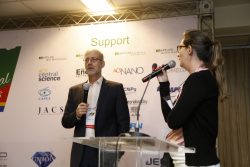
And after three plenary sessions foccusing applied research, Professor Bernhard Keimer (h index =86), in a lecture he himself classified as purely fundamental research, showed the experimental efforts he has been doing with his group at the Max Planck Institute for Solid State Research (Germany) to understand and control collective electron behaviors, more precisely the so-called “electronic correlations,” that would be responsible for generating phenomena as interesting as superconductivity. To carry out his studies, Keimer, who is director of this institute, creates “heterostructures”, which combine very thin layers of various materials (primarily metallic oxides). These are quantum materials – those whose macroscopic properties depend on the properties or behavior of their electrons. Keimer and his colleagues analyze these materials using advanced spectroscopy techniques, thus manage not only to understand but also to begin to control the correlations among small and difficult-to-study entities such as spins and charges.
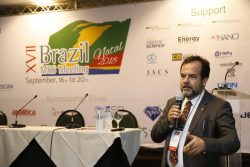
The relationship between energy, materials and sustainability returned to the plenary sessions on Wednesday morning in the lecture of Brazilian scientist Carlos Frederico Oliveira Graeff, Professor and Pro-Rector of Research at UNESP (Brazil). The speech began with an overview on the use of different sources of energy. Currently 2/3 of the electricity that mankind consumes comes from fossil fuels responsible for the greenhouse effect. Nevertheless, that relationship will change progressively until 2040 due to the significant increase in solar and wind energy in the energy matrix. In fact, these are energy sources capable of delivering energy in quantities much higher than our current human demand (more than 3,000 times in the case of sunlight). After explaining the fundamentals of the photovoltaic effect, responsible for the conversion of sunlight into electricity, Graeff talked about two types of solar cells that can compete with those of silicon – the latter already widely marketed. The scientist showed the advantages and disadvantages of dye-based and perovskite-based solar cells, and cited the contributions his research group and collaborators have made to the development of these devices. The success of solar cells depends on properly matching a range of materials that work together, said Graeff, casting the challenge to the research community in the room.
[See the plenary file of Carlos Graeff in our Slideshare https://www.slideshare.net/SBPMat/materials-for-the-optimization-of-solar-energy-harvesting ]
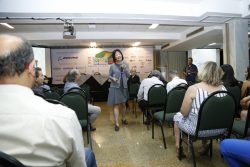
Sustainability also permeated the plenary session of You-Lo Hsieh, Distinguished Professor at UC Davis (USA). The scientist placed the current moment in the second industrial revolution, initiated around 1850 and driven by the use of oil to generate energy and plastic materials, and by the advances in Materials Science and Engineering. On the one hand this revolution brought products that make human life more comfortable, said Hsieh, but it also increased by thousands of times the carbon dioxide emissions and created pockets of litter in the oceans, to name just a few of the consequences. Hsieh develops new materials, such as nanofibers and biopolymeric aerogels, which could make up a different economy, based on low environmental impact chemical processes and on the use of biomass (the set of living organisms, from bacteria to animal or vegetable waste). With the partnership of companies, she hopes to transform these materials into new products that generate new markets. Professor Hsieh pointed some challenges of implementing such an economy, from connecting technology development to market demands, to achieving consumer acceptance.
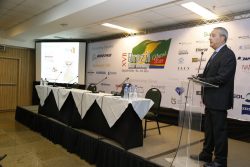
Biomedical applications returned in the penultimate plenary of the event. Pietro Matricardi, Professor at the University of Rome “La Spienza”, spoke about his work with hydrogels (gels with high water content) based on polysaccharides (natural polymers composed of long chains of simple sugars, monosaccharides). Matricardi explained that the hydrogel combined with the polysaccharide can form an intelligent material capable of adhering to living tissues, covering their surface without leaving interstices and interacting positively with them. The gel can also be carried with some drug or compound, which will be released gradually into living tissues. In collaboration with a dentist, Matricardi tested the effects of his hydrogel, loaded with an anti-inflammatory and hydroxyapatite (used for bone regeneration) in patients with severe periodontitis, and they could see very good results. In its nano version, when properly manufactured the hydrogel can carry one or more drugs within the organism and deliver them at the right measure and place. Such is the case of a prostate cancer treatment drug which should be administered together with an anti-inflammatory. Nanohydrogels, whether or not loaded with drugs, may also function to treat skin bacterial infections, as demonstrated by good results from studies conducted with rats by Matricardi.
[See Joan Ramón Morante Lleonart’s plenary file in our Slideshare https://www.slideshare.net/SBPMat/polysaccharide-hydrogels-a-versatile-tool-for-biomedical-and-pharmaceutical-applications ]
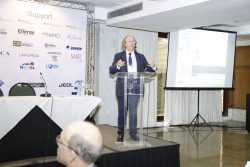
The last plenary lecture of the event began with an image that is as well known as it is worrying: increasing carbon dioxide emissions and global warming. “The circular economy of carbon dioxide is a major challenge for humanity,” said lecturer Joan Ramón Morante Lleonart (h index=82), director of the Institute of Energy Research of Catalonia (IREC), professor at the University of Barcelona and editor of the Journal of Physics D. This concept refers to removing from the environment the excess of carbon dioxide generated by human activities, capturing it and transforming the molecule into useful compounds (such as methanol, methane or formic acid), capable of generating products and fuels. To break the CO2 molecule at an industrial scale requires a lot of energy, which can ideally be obtained from renewable sources. Throughout this “recycling” process of carbon dioxide, materials once again play crucial roles. However, the existing materials generally do not effectively meet, in real conditions, the needs for this recycling to become a reality. Professor Morante pointed out a series of challenges for Materials Science and Technology, related to the development or improvement of nanomaterials for the capture and purification of carbon dioxide, materials for cathodes and anodes used in photoelectric processes, corrosion resistant materials for reactors and, mainly, catalytic nanomaterials for the reduction of carbon dioxide. The plenary closed the technical program of the event with a very encouraging image: that of a typical house of the circular carbon economy. This house does not need fossil fuels to meet the needs of its residents; it consumes sun, wind, air and water, it produces all the electricity and fuels it needs, and returns to the environment only fresh air.
[See Joan Ramón Morante Lleonart’s plenary file in our Slideshare https://www.slideshare.net/SBPMat/catalyst-materials-for-solar-refineries-synthetic-fuels-and-procedures-for-a-circular-economy-of-the-co2 ]
XVII B-MRS Meeting: Highlights of the symposia.
The symposium on “Degradation of materials and solutions to increase its lifespan” was a success, for the second consecutive year. We had almost 100 abstract submitted, with 24 talks and 70 posters presented during the event. At the end of the symposium, we had a fruitful roundtable were we discussed challenges and solutions on studies and development of materials, collaboration versus productivity, innovation, applied research and the development of multi-user centers. In the end, all researchers agreed that it is necessary to improve the collaboration to reduce segregation and increase productivity.
Prof. Polyana Alves Radi Gonçalves (symposium organizer)
The highlights of symposium M were the oral presentations of all invited speakers: Dr. Elisabeth Dickey (University of North Carolina, USA), Prof. J. A. Eiras (Federal University of S. Carlos, Brazil), Dr. D. Gouvea (University of S. Paulo, S.P., Brazil), Dr. I. F. Machado (University of S. Paulo, S.P., Brazil), Dr. J.C. M`Peko (University of S. Paulo, S. Carlos, Brazil), Prof. E. N. S. Muccillo (Energy and Nuclear Research Institute, Brazil), Dr. A. L. G. Prette (Lucideon, UK), Prof. V. M. Sglavo (University of Trento, Italy). They presented the state of art of novel sintering techniques of materials (Spark Plasma Sintering and Electric Field-Assisted Flash Sintering), sintering mechanisms and modeling, with profitable discussions with the attendees.
Prof. Reginaldo Muccilo (symposium organizer)
The highlights of the symposium in our opinion were the amount of works submitted and the technical and scientific quality of them. We had 110 contribution, of which 14 were oral and the rest in poster form, plus four invited speakers. The students’ oral work showed excellent quality, and most of them were presented in English. The oral sessions were well attended by the participants of the event. Finally, we were extremely satisfied with the outcome of the symposium and the event as all in the scientific sphere and in the organization by the organizing committee.
Prof. Mary Cristina Ferreira Alves (symposium organizer)
Our symposium joined experimentalists and theoreticians to discuss several current problems in Materials Science with over 100 contributions. Three distinguished invited speakers participated in the event: Timmy Ramírez Cuesta (Oak Ridge National – USA); Ignacio Sainz Díaz (Consejo Superior de Investigaciones Científicas – Spain); and Juan Andres, (Universitat Jaume I – Spain). They highlighted the technical quality of the oral and poster presentations. We realize that this was a remarkable opportunity to meet experimentalists and theoreticians currently working on fruitful ongoing collaborations and also to devise new challenges.
Prof. Miguel A. San-Miguel, Julio Ricardo Sambrano, Edison Zacarias da Silva, Elson Longo (symposium organizers)
The symposium on Nanofibers, Applications and Related Technology was organized by Prof. Cicero R. Cena (UFMS), Prof. Claudia Merlini (UFSC), Prof. Deuber L. S. Agostini (UNESP), Prof. Annelise K. Alves (UFRGS) and support of Prof. Roselena Faez (UFSCar). We received 81 abstracts, 7 oral presentations and 4 invited speakers. The invited speakers were Prof. You-Lo Hsieh (UD-Davis – USA), Prof. Abdellah Ajji (École Polytechnique-Canadá), Prof. Juan R. Rodriguez (Universidad Nacional de Ingeniería-Peru) and Prof. Florencia M. Ballarin (INTEMA-Argentina). The invited speakers, all experts and distinguished professors in the field of Nanofibers, have made important contributions to the scientific community that work in this field. The Symposium was financial supported by CAPES (edital PAEP) and CNPq (edital ARC). Interesting and highly quality works were presented in two days of the symposium. This was the first time that a Symposium devoted exclusively to Nanofibers and Applications was organized in the SBPMat Meeting, and the numbers of participants was expressive. Then we meet you at II Symposium Nanofibers, Applications and Related Technology on the XVIII SBPMat meeting to held in Camboriu in 2019.
Prof. Cicero Rafael Cena da Silva (symposium organizer)
This new edition of the Symposium in Surface Engineering covered topics of technological interest. 107 contributions were approved for oral and poster presentation. Two invited speakers came from high tech plasma-based industries. Also, a Technology Forum about Surface Engineering in Biomedical Applications and Diamond-like carbons was included in the technical program for the first time with a god enough number of attendees for the open debate. The interaction and networking between representatives of both academia and industry were a plus. Finally, one must notice that the works presented in our Symposium may be published in an special section of the Elsevier journal “Surface and Coatings Technology”.
Prof. Carlos A. Figueroa (symposium organizer)
